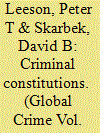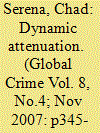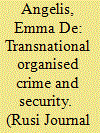| Srl | Item |
| 1 |
ID:
098350


|
|
|
|
|
| Publication |
2010.
|
| Summary/Abstract |
Why do criminals use constitutions? This article argues that constitutions perform three functions in criminal organisations. First, criminal constitutions promote consensus by creating common knowledge among criminals about what the organisation expects of them and what they can expect of the organisation's other members. Second, criminal constitutions regulate behaviours that are privately beneficially to individual criminals but costly to their organisation as a whole. Third, criminal constitutions generate information about member misconduct and coordinate the enforcement of rules that prohibit such behaviour. By performing these functions, constitutions facilitate criminal cooperation and enhance criminals' profit. To examine our hypothesis we examine the constitutions of two criminal organisations: eighteenth-century Caribbean pirates and the contemporary Californian prison gang, La Nuestra Familia.
|
|
|
|
|
|
|
|
|
|
|
|
|
|
|
|
| 2 |
ID:
080439


|
|
|
|
|
| Publication |
2007.
|
| Summary/Abstract |
This article analyses the ability of the US Army Special Forces to combat illicit networks (criminal and terrorist) through 'dynamic attenuation'. It is argued that a process of dynamic attenuation, where network ties and not the actors in the network are targeted, should replace the current US strategy of 'killing or capturing' criminal agents threatening US interests. By dynamically attenuating (not destroying) the ties between and among criminal actors and criminal organisations, the US can effectively reduce the capability of criminal organisations to operate and achieve their missions (profit and/or terror). This argument is substantiated by assessing the environments where criminal networks thrive, the characteristics of criminal networks, the utility of targeting networks instead of individual actors, and through a comparison of criminal organisations' and US Army Special Forces' strengths and weaknesses. This article concludes with implications and recommendations for US policy in the fight against criminal organisations
|
|
|
|
|
|
|
|
|
|
|
|
|
|
|
|
| 3 |
ID:
017116


|
|
|
|
|
| Publication |
Spring 1994.
|
| Description |
96-113
|
|
|
|
|
|
|
|
|
|
|
|
|
|
|
|
| 4 |
ID:
122238


|
|
|
|
|
| Publication |
2013.
|
| Summary/Abstract |
In the last issue of the RUSI Journal, the article series on transnational organised crime and security focused on a case study, looking at the challenge posed by drugscartels in Mexico and providing us with a compelling view on how organised crime can threaten the security fabric of a single country. In this issue, Peng Wang takes a similar in-depth approach to a case study, with a minutely detailed assessment of the resurgence of Chinese organised crime over the last two decades. His analysis breaks down this increasingly worrying phenomenon into three overlapping levels, scrutinising the activities of criminal organisations with mainland China, the cross-border criminal flows in the Greater China region and ethnic-Chinese organised crime in the UK. This three-level study captures the intricacies of the transnational, globalised nature of these groups' structures and networks, providing a useful resource for those wishing to better understand how Chinese organised crime flourishes at home and overseas, and how it can be countered.
|
|
|
|
|
|
|
|
|
|
|
|
|
|
|
|
| 5 |
ID:
087461


|
|
|
|
|
| Publication |
2009.
|
| Summary/Abstract |
We develop a theory of optimal networks in the context of criminal organizations. In this framework the criminals choose their network links with others according to a set of specified costs and benefits to participation. The optimal number and configuration of links within each network is solved for a set of 10,000 parameter simulations specifying the direct cost of links between agents, the benefit to connections, and the cost of being in the network with others. In addition, agents determine the size of the optimal network. This framework allows consideration of a variety of crime policy scenarios. In particular, removing the 'key player', the best strategy when the network is exogenous, may not be the optimal strategy in an environment in which the agents can change the size and structure of the network endogenously. More generally, optimal crime policy may be different if the criminals are aware of the policing strategy and can alter their network.
|
|
|
|
|
|
|
|
|
|
|
|
|
|
|
|